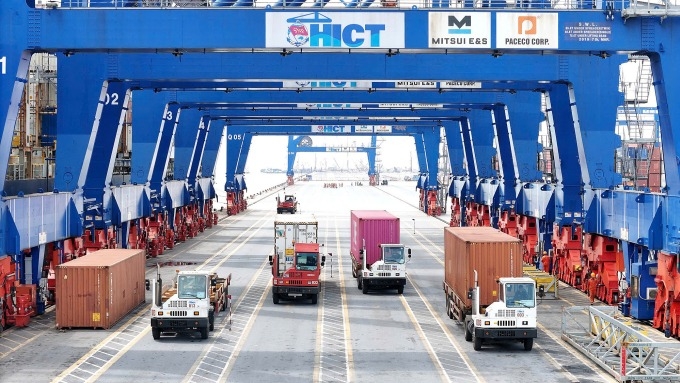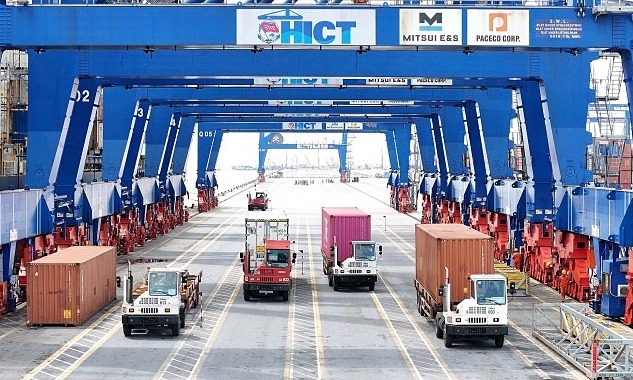Since August 7 tariffs of 10-41% are in place on the majority of the US’s trade partners. Vietnam faces a 20% rate, lower than President Donald Trump’s initial proposal of 46%.
Pham Van Viet, chairman of clothing company Viet Thang Jean, says rising input costs and shrinking profit margins are putting pressure on the textile and garment industry.
“This is a seasonal business with short order cycles. Tariff changes make it hard to renegotiate prices, especially for finalized contracts.”
Nevertheless, most exporters were not caught off guard since they began preparing response plans as early as in April, when the US first announced the tariffs.
“We were ready for a 30-46% rate, and so 20% is actually good news,” Nguyen Dinh Tung, CEO of Vina T&T Group, an agricultural products exporter, says.

Lach Huyen port in Hai Phong City. Photo by VnExpress/Le Tan
Many Vietnamese businesses have been turning to market and product diversification as their first line of defense against the tariffs. The US still accounts for 46% of Vina T&T’s exports of around US$50 million in the first half of this year.
But the company has recently expanded to Japan, South Korea and the EU, cutting its US share from 65% last year.
It exports fruits and also processed goods like fish sauce, rice paper and preserved fruits.
A survey of exporters conducted on over 1,500 firms in June by the Private Economic Development Research Board and VnExpress found that over half are looking for new markets to manage the tariff risks. Nearly 35% of domestic producers also follow this strategy, according to the survey.
Companies in manufacturing, services, agriculture, forestry, and fisheries are shifting away from the US market, with only a small proportion considering raising prices or sourcing from the US to offset the tariffs’ impacts.
Since April SK Foods, which exports rice-based products like straw, vermicelli, noodles, pasta, and pho, has been planning to switch to the EU, South Korea, Japan, Singapore, and the UAE.
Vietnam’s 17 free trade agreements with over 60 countries and 70 bilateral cooperation frameworks offer businesses an advantage when entering new markets.
Dr. Bui Quy Thuan of the faculty of international business and economics at the Phenikaa School of Economics, Hanoi, said the deals allow businesses to enter the EU, Japan, South Korea, and ASEAN member-countries.
The U.S. only accounts for 13% of global imports, meaning Vietnamese companies have enormous room to diversify their export markets.
Companies are also negotiating with partners to share the tariff costs. Viet Thang Jean, for instance, has renegotiated to split the 3% increase resulting from higher tariffs, with importers.
Vietnam targets export growth of 12% this year to US$450 billion.
As for its trade with the U.S., in the first five months of this year they rose by 36.5% to US$77.4 billion, with its exports being worth US$71.7 billion. Vietnam’s surplus of US$64.8 billion was fourth globally behind those of only China, Mexico and Iceland.
In the long term, as trade tensions grow, experts say Vietnamese companies must improve their strategies, resources and competitiveness.
Do Thien Anh Tuan, a lecturer at Fulbright University Vietnam’s School of Public Policy and Management, advises companies to move away from manufacturing cheap products and invest in value-added products, technology, management, and innovation.
He stressed the need for having a stronger supporting industry to reduce dependency on imported components from countries like China and South Korea. Companies must also improve their ability to meet international standards for environment, labor and origin, he said.
“This will help businesses avoid trade defense lawsuits and gain access to tough markets like the E.U. and Japan.”
Many companies are already switching to local supply chains and finding new sources of input materials. Viet Thang Jean buys 50% of its materials domestically and aims to increase this to 85% in the next three years.
Sunhouse Group, a company that makes household appliances, has made major investments in factories, technologies and production capabilities, chairman Nguyen Xuan Phu says. It is now nearly self-sufficient across the entire manufacturing process, from microchips and molds to final assembly, he says.
Sunhouse targets exports of VND 3 trillion (US$114.4 million) this year, he says.
“Vietnam has the opportunity to move up in the global supply chain if we can make the most of our manufacturing and technological strengths.”
Business leaders point to rising production costs and limited support policies for the manufacturing sector as ongoing challenges. They call for more tax, land and credit incentives to help them take advantage of the global supply chain shifts.
Fulbright’s Tuan believes the government should adopt policies that encourage Vietnamese businesses to expand overseas with a focus on FTA markets. “These efforts will be critical for Vietnam to stay competitive and boost its global standing in the long run.”
